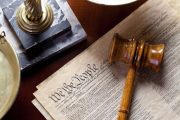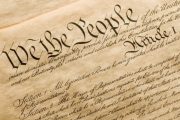A homeowner suddenly confronted by a knife-wielding intruder reaches desperately for a handgun with which to defend himself. But the firearm lies disassembled and unloaded in a drawer, useless. Before the homeowner can reassemble and load his pistol, and confront his attacker, the assailant strikes, and strikes again — with fatal results.
The real cause of the homeowner’s death in this scenario? That he had the misfortune to reside in the District of Columbia. For besides banning most semiautomatic pistols (the type of firearm that most knowledgeable Americans prefer for personal self-defense), the District requires that all registered handguns possessed by its civilian residents remain unloaded and either disassembled or fitted with a trigger lock unless there is a “reasonably perceived threat of immediate harm to the person.”
Precisely how, except as a club, is an individual supposed to use a handgun that is unloaded and disassembled or trigger-locked to protect himself from immediate harm? The District leaves that to speculation. But the District’s attorney general has explained that “we are trying to balance the right to have a handgun for use of self-defense in the home, with protecting our citizens.”
One might have thought that having “a handgun for use of self-defense in the home,” fully loaded and ready to fire at a moment’s notice, is one very good way of “protecting our citizens.” Apparently the District’s officials imagine otherwise, and they intend to enforce their fantasies on the city’s crime-plagued residents, even if the consequence is those citizens’ otherwise preventable deaths or severe bodily injuries at the hands of homicidal criminals.
To be clear, the above scenario pertains to what could happen in Washington, D.C., today … or tomorrow. Amazingly, this is the selfsame District of Columbia that on June 26 lost the landmark Second-Amendment case District of Columbia v. Heller in the U.S. Supreme Court. But perhaps not so surprisingly, after all. Though Heller struck down the then-existing D.C. prohibition against handguns, it also allowed for the regulation of guns. D.C.’s post-Heller regulations still make it virtually impossible for a law-abiding citizen to have a gun ready for immediate self-defense in his home, and Dick Heller — the named party in District of Columbia v. Heller — and two other plaintiffs have already filed a complaint to this effect in U.S. District Court.
Could Heller allow gun regulation to the point that the regulation could become a prohibition for all practical purposes? What effect will it have, if any, on existing or future gun laws in other jurisdictions throughout the country?
Debating the Decision
Exactly what Heller means seems to be an open question. “Anti-gun politicians can no longer deny that the Second Amendment guarantees a fundamental right,” exults the National Rifle Association’s chief lobbyist, Chris Cox. Nonetheless, Paul Helmke, president of the Brady Campaign to Prevent Gun Violence, promises that “our campaign to enact sensible gun laws will be undiminished by the Supreme Court’s decision in the Heller case.” And the National Association for Gun Rights warns that Heller “is far from a victory for gun owners. It is already being used successfully to infringe upon the rights of gun owners across the country.”
Unfortunately, the actual language of Heller makes clear that it is far from a major victory for gun owners. As we will show, the majority opinion by Justice Antonin Scalia in Heller is the legal equivalent of a squib load.
In firearms parlance, a “squib load” denotes a cartridge that ignites, but does not generate the pressure normally obtained with its particular content of primer, powder, and bullet. As a result, the bullet will not hit the target. Far worse, it may simply lodge in the barrel, creating a hazardous obstruction if not removed before another round is fired.
Certainly Heller did not hit what patriots hoped would be its target: a thoroughgoing and correct construction of the Second Amendment. Heller holds only that the District’s “ban on handgun possession in the home violates the Second Amendment, as does its prohibition against rendering any lawful firearm in the home operable for the purpose of immediate self-defense.” Yet, notwithstanding Heller, the District continues to require that registered handguns remain unloaded, and either disassembled or disabled by a trigger lock, until, in all probability, it would be too late to use them for self-defense. Apparently the District’s officials intend to argue that these requirements remain valid under Heller because they do not actually prohibit “rendering any lawful firearm in the home operable for the purpose of self-defense” — they simply inhibit the process so thoroughly that, in many cases, the firearm’s owner will suffer death or severe injury, rather than succeed in defending himself. After all, “the right of the people to keep and bear Arms” does not explicitly include a right to “keep and bear Arms” that are fully functional at all times, does it?
Scalia Weighs In
To compound the problem, various extraneous, ill-considered, and dangerous statements in Justice Scalia’s opinion actually undercut the protections the Second Amendment guarantees, providing proponents of “gun control” with rhetorical ammunition, not simply to resist enforcement of the amendment against statutes already on the books (as the District of Columbia is doing), but even to promote further restrictions on “the right of the people to keep and bear Arms.”
One of the most egregious of such statements in Justice Scalia’s opinion is that the Second Amendment protects “the people’s” private possession of only those “Arms” “of the kind in common use at the time,” and which are not “dangerous and unusual weapons” that have been “prohibit[ed]” by law. Thus, the amendment would supposedly not guarantee common Americans’ acquisition of fully automatic firearms. But why should this be so?
The Second Amendment provides: “A well regulated Militia, being necessary to the security of a free State, the right of the people to keep and bear Arms, shall not be infringed.” Self-evidently, whatever that “right” may entail, it must conduce to maintenance of “a well regulated Militia.”
In pre-constitutional times, the militia included every able-bodied, adult, free man in every colony; and today, because of the legal emancipation of women, must include them, too. In the pre-constitutional period, the firearms of militiamen and of regular soldiers were usually of the selfsame type (generally smoothbore muskets); and militiamen often brought to the field technologically superior arms (rifled muskets). Which is why the militia could serve alongside of, and where necessary oppose, regular infantry and cavalry. Certainly, that era knew no prohibitions of militiamen’s possession of any type of firearms the regular army used.
Today, both in the United States and throughout the world, fully automatic firearms are “in common use” by soldiers in standing armies to which the militia are to serve as adjuncts, counterweights, or opponents, as the situation demands. Thus, a practical construction of the Second Amendment demands that militiamen possess such firearms — and therefore that “the people” in general possess them, because militiamen and “the people” are one and the same.
Yet Justice Scalia considered this possibility “startling,” because “it would mean that the National Firearms Act’s restrictions on machineguns … might be unconstitutional.” Why, though, is the conclusion that some statute is unconstitutional a reason for misinterpreting the Second Amendment so as to ensure that the statute will not be struck down?
Justice Scalia took note of the possible “object[ion]” that “if weapons that are most useful in military service — M-16 rifles and the like — may be banned, then the Second Amendment right is completely detached from the [militia] clause. But … the conception of the militia at the time of the Second Amendment’s ratification was the body of all citizens capable of military service, who would bring the sorts of lawful weapons that they possessed at home to militia duty. It may well be true today that a militia, to be as effective as militias in the 18th century, would require sophisticated arms that are highly unusual in society at large…. But the fact that modern developments have limited the degree of fit between the [militia] clause and the protected right cannot change our interpretation of the right.”
Unless “modern developments” entail actual amendments to the Constitution, they cannot change the content of a constitutionally protected right. And what “modern developments” did Justice Scalia have in mind? That “the Militia of the several States” are no longer organized, armed, and disciplined? That they hardly exist at all in most states? (Today’s National Guard is not a constitutional “Militia” but a component of the Armed Forces.) But why are the state militias now mostly nonexistent? The fault belongs, first, to the constitutionally challenged politicians in Congress and the state legislatures and, second, to the voters themselves, who elect office holders who do not abide by the Constitution. This sorry state of affairs cannot be attributed to the concept of “a well regulated Militia,” or to anything else in the Constitution, which explicitly affirms the necessity of “a well regulated Militia.”
Don’t today’s patriots want their militia “to be as effective as militias in the 18th century”? Isn’t “the security of a free State” just as valuable — and even more in danger now than it was then? So, shouldn’t modern militiamen have access to “sophisticated arms”? And would such firearms be “highly unusual in society at large” if militiamen possessed them — inasmuch as the militia consist of almost all of the adult population of the country? The only reason “sophisticated arms” are “highly unusual” and not “in common use at th[is] time” is that rogue public officials have made them so by not recognizing who constitutes the militia, not properly arming the militia (or allowing militiamen to arm themselves), enacting unconstitutional statutes such as the National Firearms Act, and writing judicial opinions such as Justice Scalia’s in Heller. Public officials’ derelictions of their own constitutional duties cannot be made the basis for limiting individuals’ constitutionally guaranteed rights, however.
Or for destroying those rights entirely. For on the theory that firearms that are “highly unusual” and not “in common use at th[is] time” can be banned, rogue public officials could make any type of firearm “highly unusual” simply by banning private possession of it, and then using the effect of the ban as a reason for saying the Second Amendment does not apply! Just as they have removed fully automatic firearms from the possibility of “common use” by the National Firearms Act and other statutes. So, on the basis of the loose language in Heller, Americans can expect, not only that fully automatic firearms such as M-16s will continue to be banned from “common use,” but also that political hucksters will attempt to revive the Clinton-era prohibitions of semiautomatic “assault weapons” that merely resemble M-16s, and of high-capacity magazines; then to enact new restrictions on highly accurate, long-range “sniper rifles” in .338 Lapua, .50 BMG, and other supposedly “unusual” calibers; and even to impose draconian regulations on possession of many types of ammunition, so that the firearms chambered for such rounds will be rendered effectively useless.
Limiting the Law
Yet another counterproductive statement in Justice Scalia’s majority opinion is that “the right secured by the Second Amendment is not unlimited.” Scalia states: “Nothing in our opinion should be taken to cast doubt on longstanding prohibitions on the possession of firearms by felons and the mentally ill, or laws forbidding the carrying of firearms in sensitive places such as schools and government buildings, or laws imposing conditions and qualifications on the commercial sale of arms.” Also: “We identify these presumptively lawful regulatory measures only as examples; our list does not purport to be exhaustive.”
But why are these “regulatory measures” “presumptively lawful”? Statutes that arguably infringe on what the court calls “fundamental rights,” such as the rights included in the First Amendment, are presumptively unconstitutional. Are Second Amendment rights not of constitutional stature equal to those in the First Amendment, even though the Constitution recognizes only “the right of the people to keep and bear Arms” as “necessary to the security of a free State”?
Justice Scalia further muddied these waters by “declining to establish a level of scrutiny for evaluating Second Amendment restrictions” in general, holding only that no governmental interest could justify infringing specifically on “the right of law-abiding, responsible citizens to use arms in defense of hearth and home.” What other restrictions might be justified, though, he left for later cases to consider. Thus, having explicitly treated some “gun-control” measures as “presumptively lawful,” and approved of who-knows-how-many others by implication, Justice Scalia encouraged “gun controllers” to defend the panoply of modern “gun-control” legislation, and to enact new legislation of the same ilk. How far in the wrong direction this process might go is anyone’s guess.
For example, during the pre-constitutional period, “felony” denoted crimes punishable by forfeiture of all goods, with death usually superadded — and this, one would think, remains the constitutional definition, which cannot be changed except by amendment of the Constitution. Yet today “felony” in various statutes typically means a crime that entails some penalty far less drastic, usually imprisonment for more than one year. If legislators can change this definition at will, tomorrow could “felony” denote a crime punishable by imprisonment for more than a month, or a week, or a day? Could Congress and state legislatures label even traffic violations or littering “felonies,” so as to impose forfeiture of firearms rights on violators? Could anyone who violates any law or ordinance be disarmed as a consequence of the verbal trick of having the violation called a “felony”?
For another example, nowhere in the Constitution does the term “sensitive” appear as the basis for any power over the private possession of firearms. Yet many contemporary “gun-free-schools” statutes — which Justice Scalia apparently approves — prohibit most private possession of firearms within 1,000 feet of a school. Yet if 1,000 feet is valid, why could legislators not expand the forbidden zones to 10,000 or 100,000 feet? Why could they not create so many broad “gun-free zones” circumscribing “sensitive places” that no one might possess a firearm except within his own home (if he could get it there in the first instance by somehow avoiding all the neighboring “sensitive places”)?
Finally, if enough complex and onerous statutes or ordinances are enacted with respect to “the commercial sale of arms” — curtailing the number of dealers, raising prices, and limiting supplies in the guise of “business regulations” — how will “the people” ever be properly armed?
One Positive Point
The saving grace in Heller is that the unconstitutional verbiage in Justice Scalia’s majority opinion constitutes what lawyers call dicta — expressions extraneous to the issue presented to the court for decision, and therefore without legal force as “precedent.” Heller did not involve the possession of an M-16, or who might be disqualified from possessing firearms, or “gun-free zones,” or any statutes providing for “gun control” other than a few in the District of Columbia. Nonetheless, anti-gun legislators, politicians, special-interest groups, and media in every bastion of “gun-control” irrationality and fanaticism are already attempting to exploit the bare language, whatever its lack of legal effect, in new plots to disarm “the people.”
So what good is Heller in the grand scheme of things? It protects only a narrow right for an individual to possess a handgun at home for purposes of self-defense. And it leaves open a wide hole for old and new regulations, which will aim at inhibition, constriction, and ultimately effective prohibition of even the right Heller recognizes.
Most importantly, Heller poorly serves the core purpose of the Second Amendment. In isolation, an individual’s right to possess firearms for the purpose of self-defense in his own home can only minimally deter rogue public officials from attempting to impose a police state on this country. Without thoroughgoing organization, sufficient arms, and legal authority for collective action, Americans cannot expect to deter, let alone to resist, large-scale para-militarized police forces and other instruments of oppression. Because the militia are the constitutional institutions that provide all three — and always under control of “the people” — the Second Amendment declares them to be “necessary to the security of a free State.” The most perceptive “gun controllers” — all of whom, in the final analysis, intend to impose something other than “a free State” upon common Americans — know this, and therefore bend their every effort to prevent true constitutional militia from functioning in this country.
The only solution to these problems is to recognize that the vital center of “the right of the people to keep and bear Arms” is the concept of “a well regulated Militia” just as that concept was understood in pre-constitutional times and incorporated in the Constitution, and must be implemented today. That, however, will take cases other than Heller, litigated in a far different, constitutionally correct manner — or, far better yet, legislation to revitalize the militia state by state.
Edwin Vieira, Jr. is an attorney and author who concentrates on issues of constitutional law. He has won three cases in the Supreme Court of the United States.




